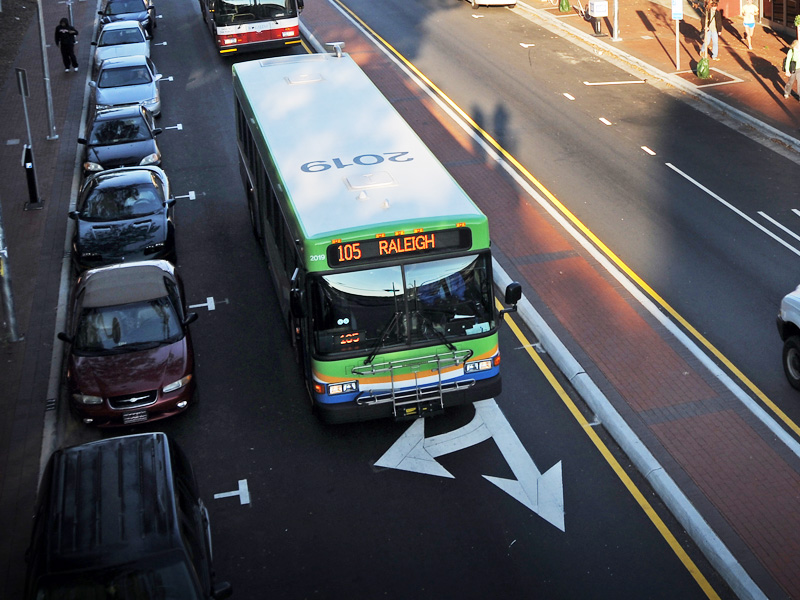
Transit systems that won new resources from ballot measures in 2016 are now steadily increasing transit service. Raleigh/Durham and Indianapolis are applying new funding to fundamental service improvements, like increasing frequency on bus routes that already serve known travel markets, and are likely to see increasing ridership overall as a result.
In Raleigh, one of the fastest growing cities in the country, bus riders are seeing benefits from a ½-cent sales tax and ten year transit plan given thumbs-up by voters in 2016. According to Go Triangle Public Information Officer Mike Charbonneau, “By August 1st, 2017, Wake County residents had new bus service on the roads on all three of our networks.”
GoTriangle conducted significant outreach to find out what changes residents wanted first. “Some of the easiest changes for us to make were adding frequency to existing bus lines. Next year, we’ll be adding new routes with the number of buses we have, but in the interim we have more service going to the places that its been needed most, like the airport. And already we’re starting to see an increase in ridership.”
Similarly, the Indianapolis 2016 ballot measure is already delivering improvements to transit riders. IndyGo began the first round of local route improvements on February 11th with the addition of nearly 250 trips each week. New service was also added on Sundays. According to IndyGo’s Director of Public Relations Lauren Day, “Investing in high density areas with frequency and a connected route system will better serve the current riders, and work to make transit a convenient option for those who don’t yet ride.”
Over the next five years, IndyGo will improve service with longer hours of service, frequencies of 10-15 mins for the majority of routes and a more useable grid network design. Walkability improvements are also coming in the near-term. Starting at the the end of 2018, IndyGo will be assessing its bus stop inventory and identifying improvements.
Both Raleigh and Indianapolis plans have longer term projects which could prove to be more problematic. The Indy Red Line Bus Rapid Transit is already delayed by Trump administration interruption of funding. The Wake County Transit Plan also allocates billions for construction of 20 miles of BRT lines and a 37-mile commuter rail line and may also in time come up against federal hostility. Thus far none of the Raleigh projects have been locally controversial, though when the BRT corridors are officially selected and fights over parking or travel lanes ensue, Charboneau realizes there will be challenges. “Hopefully this is where all the community engagement we’ve been doing pays off.”
All of this points to the wisdom of creating early success stories and building momentum for longer-term, expensive projects with nimble service improvements that can be accomplished by buying more buses and running them often. That approach doesn’t offer the “new, shiny” qualities of a rail project, but few things work like actual success. Smart politicians and business leaders can easily frame increased ridership as a good thing, and it doesn’t require the rhetorical contortions necessary to justify underperforming streetcars or commuter rail, of which there are countless examples.
 On the Brink: Will WMATA’s Progress Be Erased by 2024?
On the Brink: Will WMATA’s Progress Be Erased by 2024?
The experience of being a WMATA rider has substantially improved over the last 18 months, thanks to changes the agency has made like adding off-peak service and simplifying fares. Things are about to get even better with the launch of all-door boarding later this fall, overnight bus service on some lines starting in December, and an ambitious plan to redesign the Metrobus network. But all of this could go away by July 1, 2024.
Read More A Bus Agenda for New York City Mayor Eric Adams
A Bus Agenda for New York City Mayor Eric Adams
To create the “state-of-the-art bus transit system” of his campaign platform, Mayor Adams will have to both expand the quantity and improve the quality of bus lanes. We recommend these strategies to get it done.
Read More